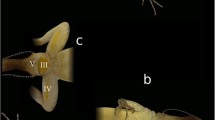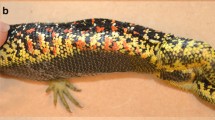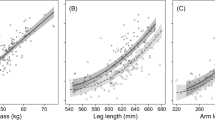Abstract
Sexual selection has driven the evolution and elaboration of a wide variety of displays and ornaments in male nonhuman primates, including capes, cheek flanges, and sexual coloration. Among the most sexually dimorphic of all primates is the drill (Mandrillus leucophaeus), the males of which can be 3 times the mass of females, possess large canines, and exhibit extremely bright sexual skin coloration. However, the function of male coloration in this species has never been examined. Here, we present data on male color (measured objectively using digital photography), dominance rank, measures of male-female association, and key sexual behaviors, of adult male drills (n = 17) living in four semi free-ranging enclosures at the Drill Rehabilitation and Breeding Center in Nigeria. We test the hypothesis that male coloration is a badge of status, indicating dominance rank, and the hypothesis that male coloration attracts females. We found that male coloration did indicate rank, and that high ranking, strongly colored males were more likely to associate with adult females, and more specifically with fully tumescent females. These males also engaged in more sexual activity. However, measures of male-female association and sexual behaviors were not related to male color once rank had been taken into consideration; i.e., for males of a given rank, females did not prefer those that were more colorful. We discuss the results in light of what is known about the wild drill social system, in which unfamiliar individuals may come together in “supergroups,” and in which quality indicators of competitive ability may be particularly important.




Similar content being viewed by others
References
Abernethy, K. A., White, L. J. T., & Wickings, E. J. (2002). Hordes of mandrills (Mandrillius sphinx): Extreme group size and seasonal male presence. Journal of Zoology, 258, 131–137.
Altmann, J. (1974). Observational study of behavior: Sampling methods. Behavior, 49, 227–267.
Astaras, C., Mulenberg, M., & Walter, M. (2008). Note on drill (Mandrillus leucophaeus) ecology and conservation status in Korup National Park, Southwest Cameroon. American Journal of Primatology, 70, 306–310.
Bercovitch, F. B. (1996). Testicular function and scrotal color in patas monkeys. Journal of Zoology, 239, 93–100.
Bergman, T. J., & Beehner, J. C. (2008). A simple method for measuring color variation in wild animals: Validation and use in geladas (Theropithecus gelada). Biological Journal of the Linnean Society, 94, 231–240.
Bergman, T. J., Ho, L., & Beehner, J. C. (2009). Chest color and social status in male geladas (Theropithecus gelada). International Journal of Primatology, 30. doi:10.1007/s10764-009-9374-x.
Boer, M. (1987). Recent advances in drill research and conservation. Primate Conservation, 8, 55–57.
Charpentier, M., Peignot, P., Hossaert-McKey, M., Gimenez, O., Setchell, J. M., & Wickings, E. J. (2005). Constraints on control: Factors influencing reproductive success in male mandrills (Mandrillus sphinx). Behavioral Ecology, 16, 614–623.
Cowlishaw, G., & Dunbar, R. I. M. (1991). Dominance rank and mating success in male primates. Animal Behaviour, 41, 1045–1056.
Cox, C. R. (1997). Drills (Mandrillus leucophaeus): Research and conservation initiatives, 1986–1996. In J. Wallis (Ed.), Primate conservation: The role of zoological parks (pp. 151–175). Norman, OK: American Society of Primatologists.
Darwin, C. (1871). The descent of man and selection in relation to sex. London: John Murray.
Darwin, C. (1876). Sexual selection in relation to monkeys. Nature, 15, 18–19.
de Ruiter, J. R., & van Hoof, J. A. R. A. M. (1993). Male dominance rank and reproductive success in primate groups. Primates, 34, 513–523.
Dixson, A. F. (1998). Primate sexuality: Comparative studies of the prosimians, monkeys, apes, and human beings. Oxford: Oxford University Press.
Dixson, A. F., Bossi, T., & Wickings, E. J. (1993). Male dominance and genetically determined reproductive status in the mandrill (Mandrillus sphinx). Primates, 34, 525–532.
Dunbar, R. I. M. (1984). Reproductive decisions: An economic analysis of gelada baboon social strategies. Princeton, NJ: Princeton University Press.
Elton, S., Bethan, J., & Morgan, B. J. (2006). Muzzle size, paranasal swelling size and body mass in Mandrillus leucophaeus. Primates, 47, 151–157.
Gartlan, J. S. (1970). Preliminary notes on the ecology and behaviour of the Drill Mandrillus leucophaeus Ritgen, 1824. In J. R. Napier & P. H. Napier (Eds.), Old World monkeys (pp. 445–480). New York: Academic Press.
Gerald, M. S. (2001). Primate color reveals social status and predicts aggressive outcome. Animal Behaviour, 61, 559–566.
Gerald, M. S., Bernstein, J., Hinkson, R., & Fosbury, R. A. E. (2001). Formal method for objective assessment of primate color. American Journal of Primatology, 53, 79–85.
Higham, J. P. (2006). The reproductive ecology of female olive baboons (Papio hamadryas anubis) at Gashaka-Gumti National Park, Nigeria. Ph.D. Thesis, Roehampton University, London.
Higham, J. P., MacLarnon, A. M., Ross, C., Heistermann, M., & Semple, S. (2008). Baboon sexual swellings: Information content of size and color. Hormones and Behavior, 53, 452–462.
Hill, W. C. O. (1955). A note on integumental colours with special reference to the genus Mandrillus. Saeugetierkündliche Mitteilungen, 3, 145–155.
Hill, W. C. O. (1970). Primates: Comparative anatomy, and taxonomy, vol 8: Cynopithecinae. Edinburgh: Edinburgh University Press.
IUCN. (2008). IUCN Red List of Threatened Species. www.iucnredlist.org (Accessed February 20, 2009).
Jarvi, T., & Bakken, M. (1984). The function of the variation in the breast stripe of the great tit (Parus major). Animal Behaviour, 32, 590–596.
Kummer, H. (1968). Social organization of hamadryas baboons. Chicago: The University of Chicago Press.
Maynard-Smith, J., & Harper, D. (2003). Animal signals. Oxford: Oxford University Press.
Møller, A. P. (1992). Female swallow preference for symmetrical male sexual ornaments. Nature, 357, 238–240.
Nagel, L., & Schluter, D. (1998). Body size, natural selection, and speciation in sticklebacks. Evolution, 52, 209–218.
Packer, C. (1983). Sexual dimorphism: The horns of African antelopes. Science, 221, 1191–1193.
Paul, A., Kuester, J., Timme, A., & Arnemann, J. (1993). The association between rank, mating effort, and reproductive success in male Barbary macaques (Macaca sylvanus). Primates, 34, 491–502.
Reed, C., O’Brien, T. G., & Kinnaird, M. F. (1997). Male social behavior and dominance hierarchy in the Sulawesi crested black macaque (Macaca nigra). International Journal of Primatology, 18, 247–260.
Rhodes, L., Argersinger, M. E., Gantert, L. T., Friscino, B. H., Hom, G., Pikounis, B., et al. (1997). Effects of administration of testosterone, dihydrotestosterone, oestrogen and fadrozole, an aromatase inhibitor, on sex skin colour in intact male rhesus macaques. Reproduction, 111, 51–57.
Schürmann, C. L. (1982). Mating behavior of wild orangutans. In L. de Boer, L. (Ed.), The Orang-Utan: Its biology and conservation (pp. 271–286). The Hague: Junk Publishers.
Setchell, J. M. (2005). Do female mandrills prefer brightly colored males? International Journal of Primatology, 26, 715–734.
Setchell, J. M., Charpentier, M. J. E., Abbott, K. M., Wickings, E. J., & Knapp, L. A. (2009). Is brightest best? Testing the Hamilton-Zuk hypothesis in Mandrills. International Journal of Primatology, 30. doi:10.1007/s10764-009-9371-0.
Setchell, J. M., Charpentier, M., & Wickings, E. J. (2005). Mate guarding and paternity in mandrills: Factors influencing alpha male monopoly. Animal Behaviour, 70, 1105–1120.
Setchell, J. M., & Dixson, A. F. (2001a). Arrested development of secondary sexual adornments in subordinate adult male mandrills (Mandrillus sphinx). American Journal of Physical Anthropology, 115, 245–252.
Setchell, J. M., & Dixson, A. F. (2001b). Changes in the secondary sexual adornments of male mandrills (Mandrillus sphinx) are associated with gain and loss of alpha status. Hormones and Behaviour, 39, 177–184.
Setchell, J. M., & Dixson, A. F. (2001c). Circannual changes in the secondary sexual adornments of semifree-ranging male and female mandrills (Mandrillus sphinx). American Journal of Primatology, 53, 109–121.
Setchell, J. M., & Kappeler, P. M. (2003). Selection in relation to sex in primates. Advances in the Study of Behavior, 33, 87–173.
Setchell, J. M., Lee, P. C., Wickings, J. E., & Dixson, A. F. (2001). Growth and ontogeny of sexual size dimorphism in the mandrill (Mandrillus sphinx). American Journal of Physical Anthropology, 115, 349–360.
Setchell, J. M., & Wickings, J. E. (2005). Dominance, status signals and coloration in male mandrills (Mandrillus sphinx). Ethology, 111, 25–50.
Setchell, J. M., Wickings, E. J., & Knapp, L. A. (2006). Life history in male mandrills (Mandrillus sphinx): Physical development, dominance rank, and group association. American Journal of Physical Anthropology, 131, 498–510.
Stevens, M., Párraga, A., Cuthill, I. C., Partridge, J. C., & Troscianko, T. (2007). Using digital photography to study animal coloration. Biological Journal of the Linnean Society, 90, 211–237.
Stevens, M., Stoddard, M. C., & Higham, J. P. (2009). Studying primate color: Towards visual system-dependent methods. International Journal of Primatology, 30. doi:10.1007/s10764-009-9356-z.
Thompson, C. W., & Moore, M. C. (1991). Throat color reliably signals status in male tree lizards, Urosaurus ornatus. Animal Behaviour, 42, 745–753.
van Schaik, C. P., & van Hooff, J. A. R. A. M. (1996). Towards an understanding of the orangutan’s social system. In W. C. McGrew, L. F. Marchant & T. Nishida (Eds.), Great ape societies (pp. 3–15). Chicago: The University of Chicago Press.
Waitt, C., Little, A. C., Wolfensohn, S., Honess, P., Brown, A. P., Buchanan-Smith, H. M. F., et al. (2003). Evidence from rhesus macaques suggests male coloration plays a role in female primate mate choice. Proceedings Royal Society London Series B (Suppl.), 270, S144–146.
Wickings, E. J., Bossi, T., & Dixson, A. F. (1993). Reproductive success in the mandrill (Mandrillus sphinx): Correlations of male dominance and mating success with paternity as determined by DNA fingerprinting. Journal of Zoology (London), 231, 563–574.
Wickings, E. J., & Dixson, A. F. (1992). Testicular function, secondary sexual development and social status in male mandrills (Mandrillus sphinx). Physiology & Behavior, 52, 909–916.
Wickler, W. (1967). Socio-sexual signals and their intra-specific imitation among primates. In D. Morris (Ed.), Primate ethology (pp. 69–147). London: Weidenfeld & Nicolson.
Wickler, W. (1968). Mimicry in plants and animals. New York: McGraw-Hill.
Wild, C., Morgan, B. J., & Dixson, A. F. (2005). Conservation of drill populations in Bakossiland, Cameroon: Historical trends and current status. International Journal of Primatology, 26, 759–773.
Wood, K. L. (2007). Life history and behavioral characteristics of a semi-wild population of drills (Mandrillus leucophaeus) in Nigeria. Ph.D. thesis, University of Massachusetts, Boston.
Zuckerman, S., & Parkes, A. S. (1939). Observations on the secondary sexual characters in monkeys. Journal of Endocrinology, 1, 430–439.
Acknowledgments
We thank The Leakey Trust for providing funding for this study. We are very grateful to James Ebe, Irene Edem, Jacob Elemi, Emmanuel Okon, and Gabriel Oshie for assistance in the field. Kathy Wood kindly read the manuscript and helped with information on the composition of the groups and Melissa Gerald provided very helpful comments on earlier versions of this work. We thank Jo Setchell and 2 anonymous reviewers for constructive comments on an earlier version of the manuscript. This research was carried out as a part of J. S. Marty’s research project for the MRes Primatology at Roehampton University.
Author information
Authors and Affiliations
Corresponding author
Rights and permissions
About this article
Cite this article
Marty, J.S., Higham, J.P., Gadsby, E.L. et al. Dominance, Coloration, and Social and Sexual Behavior in Male Drills Mandrillus leucophaeus . Int J Primatol 30, 807–823 (2009). https://doi.org/10.1007/s10764-009-9382-x
Received:
Accepted:
Published:
Issue Date:
DOI: https://doi.org/10.1007/s10764-009-9382-x




